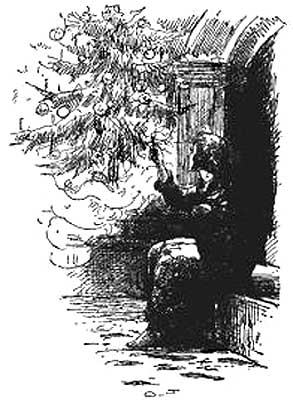
A.J. Bayes’ 1889 illustration for Hans Christian Andersen’s “Little Match Girl”.
My father recently dug out a box of old home videos—recordings I remember being made but which I had never seen. They spanned from 1988 to about 1995. They are all of our family’s video records, these five or six tapes, and in them it is always Christmas.
Christmas envelops us (at least, those of us in the U.S.) like a blanket. The songs are in your supermarket, the lights in your neighborhood, the specials on your TV, the tree in your office lobby. There is no escaping its reach if you spend any portion of your time interacting with the outside world, regardless of the religion you were (or were not) raised in, of what faith you do (or do not) practice now. If there ever was a war on Christmas, let it be noted that Christmas won.
In the videos, my brothers and I look like we’re attached to some kind of electrical current, our eyes wide and fists clenched, legs bouncing up and down. We are not allowed to see the tree, or our presents, until the filming ritual is finished. We sit on the steps of our DC home with our mother (our father operates the camera) and speak, year after year, almost in song: “Merry Christmas 1990,” “1991,” “1992”—a childhood measured in holiday.
According to my local Rite-Aid, Christmas starts sometime in late September and ends in early January. It is neither an event nor a day but in fact a season, as legitimate in this Christianity-steeped country as autumn or winter, even as it overlaps both. And how do you grapple with a month? Two months? Or, by Rite-Aid’s figures, around four? No holiday is as pervasive or long lasting: one does not so much celebrate Christmas as live through it. The train will come regardless of what you or I will do.
The sheer number of Christmas symbols staggers the mind. From religious (an infant, a manger, a star) to pagan (a Yule log, a Christmas tree), horticultural (holly, mistletoe, poinsettia) to animal (turtle doves, reindeer), meteorological (snow) to geographical (the North Pole, Bethlehem), decorative (wreaths, lights, bells, stockings) to culinary (fruitcake, candy canes, gingerbread, goose), active (sleigh rides, ice skating, caroling) to passive (chestnuts roasting, children sleeping), not to mention all the music, poetry, plays, movies, ballets, TV specials dedicated to the subject, much less Santa Claus and his retinue of iconography—this motely, gargantuan, and still growing body of symbols speaks to the broad range of influences this winter celebration has drawn from. There is a Christmas for every taste—from medieval polyphony to Die Hard—and it is...
You have reached your article limit
Sign up for a digital subscription and continue reading all new issues, plus our entire archives, for just $1.50/month.
Already a subscriber? Sign in




